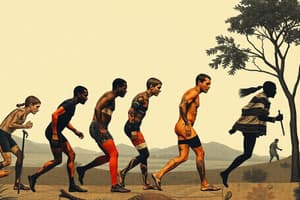Podcast
Questions and Answers
What advantage does endurance provide in terms of energy acquisition for humans?
What advantage does endurance provide in terms of energy acquisition for humans?
- It reduces the amount of energy needed for foraging
- It allows for acquiring more energy at a faster rate (correct)
- It increases the total energy expenditure during foraging
- It minimizes the need for physical activity
How do humans differ from non-human great apes in terms of energy expenditure during foraging?
How do humans differ from non-human great apes in terms of energy expenditure during foraging?
- Humans spend more energy than great apes while foraging
- Great apes spend less energy than humans while foraging
- Humans and great apes exhibit similar levels of energy expenditure (correct)
- Great apes require less energy to forage due to their physiology
According to the Inactivity Mismatch Hypothesis, what are humans physiologically adapted for?
According to the Inactivity Mismatch Hypothesis, what are humans physiologically adapted for?
- Consistent muscle activity throughout the day (correct)
- Avoiding all types of physical activity
- Intermittent bursts of high-intensity activity
- Minimal muscle activity to conserve energy
What characterizes the sedentary behavior of adults in the US and UK according to the text?
What characterizes the sedentary behavior of adults in the US and UK according to the text?
How do individuals with more sedentary jobs differ in sitting behavior compared to those with active jobs?
How do individuals with more sedentary jobs differ in sitting behavior compared to those with active jobs?
How much more energy does sitting with back support require compared to lying down?
How much more energy does sitting with back support require compared to lying down?
What type of muscle activity is associated with human physiology according to the Inactivity Mismatch Hypothesis?
What type of muscle activity is associated with human physiology according to the Inactivity Mismatch Hypothesis?
What was the impact of the turning point mentioned in the text on physical activity levels within a community?
What was the impact of the turning point mentioned in the text on physical activity levels within a community?
How did medical advancements impact the survival rate against infectious diseases within a population?
How did medical advancements impact the survival rate against infectious diseases within a population?
From a population perspective, what did the opportunity for less physical activity lead to?
From a population perspective, what did the opportunity for less physical activity lead to?
In what way did the turning point discussed in the text contribute to current critical threats to health and wellbeing?
In what way did the turning point discussed in the text contribute to current critical threats to health and wellbeing?
How did the turning point affect the balance between physical activity levels in a community?
How did the turning point affect the balance between physical activity levels in a community?
What was one consequence of a larger portion of the population avoiding physical activity?
What was one consequence of a larger portion of the population avoiding physical activity?
How did medical advancements enable the post-turning point population to combat infectious diseases effectively?
How did medical advancements enable the post-turning point population to combat infectious diseases effectively?
What is the relationship between physical activity levels and threats to health as discussed in the text?
What is the relationship between physical activity levels and threats to health as discussed in the text?
What did the emergence of critical threats to health and wellbeing result from?
What did the emergence of critical threats to health and wellbeing result from?
What was one effect of a larger portion of the population being able to survive infection?
What was one effect of a larger portion of the population being able to survive infection?
Flashcards are hidden until you start studying




